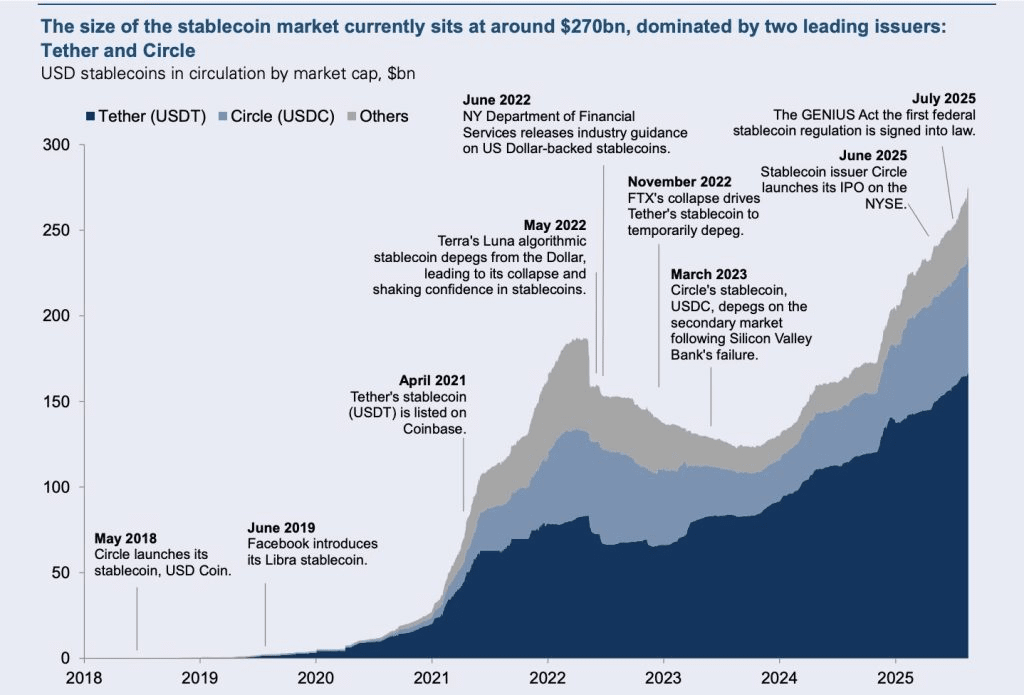A report from Goldman this week predicts that trillions of dollars could soon flood into the stablecoin market. This forecast comes after last quarter's trading volume reached an astonishing $7 trillion, indicating that the global financial landscape is on the verge of a seismic shift.
This prediction comes as US Treasury Secretary Scott Bessent told Wall Street that stablecoins will play an increasingly significant role in government bond demand. The market has already reacted, with August valuations swelling to $271 billion.

Goldman predicts USDC will grow by $77 billion in the stablecoin 'gold rush'.
In a new research paper released by Goldman Sachs on Wednesday, the bank believes that payments are the most obvious growth path, although most stablecoin activity today remains concentrated on cryptocurrency trading and demand for dollar exposure outside the US.
Goldman researchers noted that the global stablecoin market, valued at around $271 billion, is dominated by Tether's USDT, which continues to hold the top spot among issuers.

The second-largest issuer, Circle, bets that recently passed US legislation and a potentially crypto-friendly Trump administration will provide a regulatory environment conducive to expanding USDC adoption.
The bank wrote: "Stablecoins represent a $271 billion global market, and we believe USDC (the stablecoin issued by Circle) benefits from market share growth both within and outside the Binance platform, as ongoing stablecoin legislation legitimizes the ecosystem, and the crypto ecosystem may also be catalyzed by legislation.
The report predicts that Circle's USDC could grow by $77 billion between 2024 and 2027, with a compound annual growth rate of about 40%. Goldman describes this expansion as the beginning of a 'stablecoin gold rush' driven by legislative clarity and the broader integration of digital assets into the financial system.
Goldman also emphasized that while stablecoins can reconnect various aspects of finance, they are not expected to replace established consumer card networks like Visa and Mastercard. Instead, these companies may still be central to payment infrastructure, managing dispute resolution, rewards, and transaction allocation.
"Visa expands the potential annual payment volume of the payment market to ~$240 trillion, with consumer payments representing ~$40 trillion of annual spending. B2B payments account for about ~$60 billion, while P2P payments and remittances make up the rest.
The GENIUS Act unleashes the potential of stablecoins, which will drive trillions in US Treasury demand.
Treasury Secretary Scott Bessent emphasized that stablecoins are not just a niche crypto product. He privately told Wall Street, according to the Financial Times, that digital tokens backed 1:1 by the dollar and Treasuries could become a major source of demand for government bonds.
He stated publicly that stablecoins will "solidify the dollar's status as the global reserve currency, expand access to the dollar economy for billions around the world, and lead to a surge in demand for US Treasuries.
Bessent's optimism surfaced following the signing of the GENIUS Act into law in July, which provides a clear federal framework for stablecoins. The White House stated that the Act "aligns state and federal stablecoin frameworks, ensuring fair and consistent regulation nationwide.
According to the law, issuers must maintain 1:1 reserves of highly liquid, ultra-safe assets like cash and short-term Treasuries. Compliant stablecoins can now become a multi-trillion-dollar engine for US debt demand.
Economists remain divided on the scale of the impact. UBS's Paul Donovan warned that this trend might just redistribute existing Treasury demand rather than create new buyers. Nonetheless, evidence suggests that the movement of stablecoins has affected the market. A study by the Bank for International Settlements found that inflows tend to lower three-month Treasury yields, while outflows trigger more severe upward pressure.
USDC vs USDT: Who Will Win the Compliance Era?
Goldman Sachs analysts believe the GENIUS Act could tilt the balance of power in the stablecoin market, with Circle's USDC poised to carve out a place against Tether's dominant USDT. This landmark legislation establishes a standard aligned with Circle's operating model but has long raised questions about Tether's reserve transparency.
Tether has a market capitalization of $165 billion, while USDC's market cap stands at $66 billion, currently facing adjustment pressure. The company claims it is working to comply with the GENIUS Act, but Goldman noted that regulatory clarity benefits US issuers with audited reserves, which could give Circle an advantage in the long run.
For Circle, the clarity of regulation comes at an important moment. The company's initial public offering earlier this year gave it new visibility, while partnerships with companies like Robinhood demonstrate the potential for stablecoins to be embedded within broader payment and financial systems.
In contrast, Tether must prove that it can adapt to stricter standards without losing its global user base, particularly in its dominant emerging markets.
With the onset of the compliance era, the competition between USDC and USDT affects not only the future of stablecoins but also the dynamics of US Treasury demand, with implications stretching from Wall Street to Washington.

